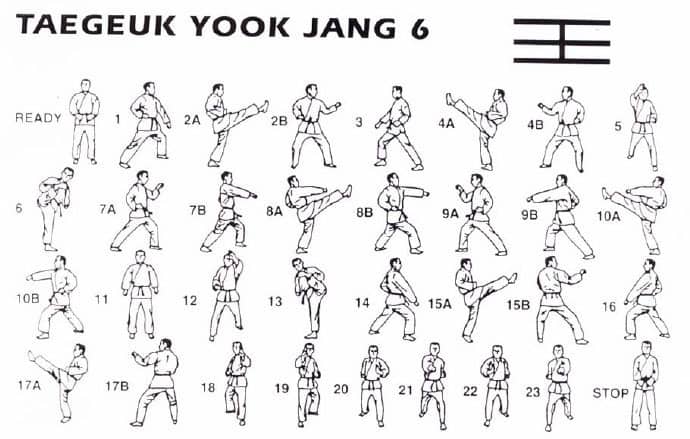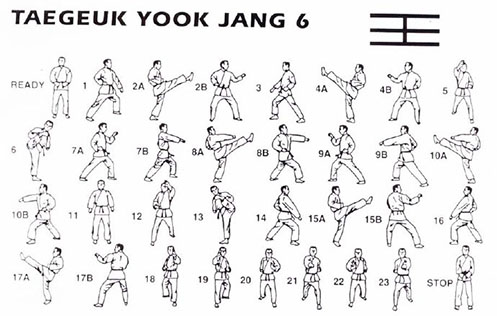
The TaeKwonDo Form 6 or Poomsae Taegeuk Yuk (Yook) Jang applies to the principle of Gam of Palgwe. Gam is male, and it symbolizes North. Through Gam, we learn that we can overcome every difficulty if we go forward with self-confidence and persistence, easy to bend but not to break.
Gam is water, which is formless, yet never loses its nature, though it may conform to the vessel in which it finds itself. Water always flows downward, and in time can wear away the hardest granite.
Like water, Taegeuk Yook Jang is flowing and gentle, yet destructive. It teaches that someone, when faced with a challenge, can overcome it by persistence and unwavering belief. To give this poomsae the appearance of continuity, its separate sequence of motions are connected by the Front Kick.
This form uses the Outside High Block, palm out and Middle and High Reverse Single Knife Hand Blocks, which both require fluidity, as the hip and body have to twist 45 degrees toward the target.
This form also brings with it the Round House Kick, followed by a quick change of direction, which requires great balance and coordination to remain fluid, like water.
Terms Used With This Form
- Joon Bi Seogi– Ready Stance (i.e. “at ease”)
- KiHap – Shout
- Poomsae – Form
- Eolgool Makki – High Block
- Sonnal-bakat Makki –Knife Hand Block
- Momtong Makki – Middle Block
- Dollyeo Chagi- Round House Kick
- Ap Chagi – Front Kick
- Ap Kubi – Front Stance
Video Of TaeKwondo Blue Belt Form – Poomsae Taegeuk Yuk Jang
Its easier to learn with both a visual and written form of this (and all) TaekwonDo Forms
TaeKwonDo Blue Belt Form – Taegeuk Yuk Jang -Step By Step
Step 1:
From your Joon Bi Seogi, turn 90 degrees to your left by moving your foot in a Front Stance and do a left low block.
Step 2:
Perform a Right Front Kick and land your foot behind your other leg, then do a left middle block.
Step 3:
Turn 180 degrees to your left, with your right leg in a Front Stance and then do a right low block.
Step 4:
Perform a left front kick and land your foot behind your other leg, then do a right middle block.
Step 5:
Turn 90 degrees to your right, then simultaneously step forward once with your left foot and perform a Hansonnal Montong Maki.
Step 6:
Deliver a roundhouse kick with your right leg, land your foot in front of your left, turn 90 degrees to your left, step forward once with your left foot, perform a left middle block, and immediately follow it up with a right middle punch.
Step 7:
Deliver a front kick with your right foot, landing it in front of your left foot, and do a left middle punch.
Step 8:
Turn 180 degrees to your right on your left foot, and in a Right Front Stance consecutively perform a right middle block and a left middle punch.
Step 9:
Perform a left front kick and follow it up with a right middle punch.
Step 10:
Face front by turning 90 degrees to the left and align your feet together so that they are parallel to one another; this is Narani Seogi. Do this as you form an X shape with your arms on your torso, then move it lower while still maintaining an X shape until you’ve reached your hip level and bring them apart from each other, straighten them out, and keep them sturdy to block both of your sides; this is called your Gechio Are Maki.
Step 11:
Step your right foot forward once while performing a Hansonnal Montong Maki with your left hand.
Step 12:
Perform a left roundhouse kick and turn 270 degrees to your right on your right foot as you drop your foot behind it and step forward once with your left foot, so it is in front of the other in a Front Stance position with your arms in a right low block.
Step 13:
Perform a left front kick, land it behind your right foot, and put your arms in a right outside block; this is just like a middle block, but your knuckles face your opponent.
Step 14:
Turn 180 degrees to your left on your right foot and half-step your left foot forward while putting your arms in a left low block.
Step 15:
Perform a Right Front Kick, land it behind the other leg, and perform a left outside block.
Step 16:
Turn 90 degrees to your right on your left foot and execute a left Hansonnal Monton Maki
Step 17:
Step backwards once with your left foot and switch your left Hansonnal Monton Maki for a right Hansonnal Monton Maki.
Step 18:
Step backwards once with your right foot and switch your right Hansonnal Monton Maki for a left Hansonnal Monton Maki and follow it up with a right middle punch right after.
Step 19:
Step backwards once with your left foot and switch your left Hansonnal Monton Maki for a right Hansonnal Monton Maki once again and follow it up with a left middle punch right after. Go back to your Joon Bi Seogi after afterwards.
Keep in mind The following:
1. A form should begin and end at exactly the same spot. This indicates the quality of the student’s stances and technique.
2. Correct posture and body position must be maintained at all times.
3. Muscles of the body should be either tensed or relaxed at the proper, critical moments in the form.
4. The exercise should be performed in a rhythmic movement with an absence of stiffness.
5. Movement should be accelerated or decelerated according to the specifications of that pattern.
6. Exhale on exertion of each technique in order to maximize power.
7. Each pattern should be perfected before moving to the next.
8. Students should know the purpose of each movement.
Tips
In performing this form as well as all the others, you should think not of executing techniques in a vacuum, but rather of responding to attacks from a number of opponents surrounding you.
You should always turn your head first, look at your imaginary opponent, then perform the required block or attack.
It’s also worth mentioning to listen to your body and don’t force yourself to learn something you personally aren’t ready for yet; in cases like these, practice slowly until you feel comfortable enough to try again!
Reminders
Always wait for the “Baro!” or end signal of your master before getting into Joon Bi Seogi after every form; this shows that you are taught to be disciplined during Tae Kwon Do sessions.


